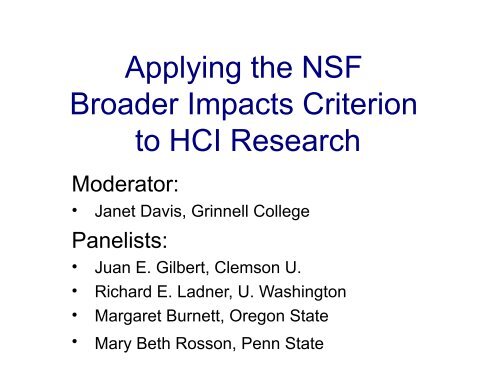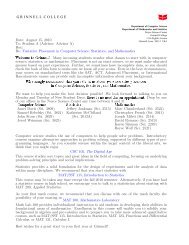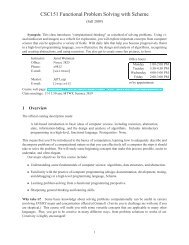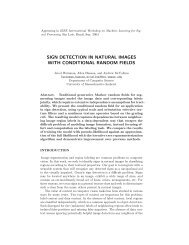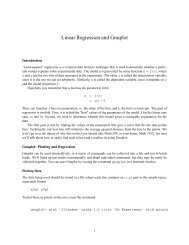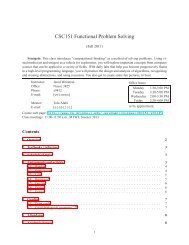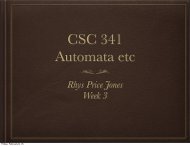Slides, with notes from SIG meeting (PDF) - Computer Science
Slides, with notes from SIG meeting (PDF) - Computer Science
Slides, with notes from SIG meeting (PDF) - Computer Science
Create successful ePaper yourself
Turn your PDF publications into a flip-book with our unique Google optimized e-Paper software.
Applying the NSF<br />
Broader Impacts Criterion<br />
to HCI Research<br />
Moderator:<br />
• Janet Davis, Grinnell College<br />
Panelists:<br />
• Juan E. Gilbert, Clemson U.<br />
• Richard E. Ladner, U. Washington<br />
• Margaret Burnett, Oregon State<br />
• Mary Beth Rosson, Penn State
Agenda<br />
• Overview - Juan<br />
• Past, present, & future - Richard<br />
• Models for success - Margaret<br />
• More models for success - Mary Beth<br />
• Q&A, Discussion<br />
2
Broader Impacts<br />
CHI 2011<br />
Juan E. Gilbert<br />
Clemson University<br />
3
The broader impacts categories as<br />
defined by the NSF are:<br />
1. Advance science while promoting teaching, training<br />
and learning<br />
2. Broaden participation of underrepresented groups<br />
3. Enhance infrastructure for research and education<br />
4. Provide broad dissemination to enhance scientific and<br />
technological understanding<br />
5. Highlight the benefit to society<br />
4
America Competes Act<br />
• On January 4, 2011 Pres. Obama signed<br />
into law the<br />
– “America Creating Opportunities to Meaningfully<br />
Promote Excellence in Technology, Education,<br />
and <strong>Science</strong> (America COMPETES)<br />
Reauthorization Act of 2010”<br />
• Broader Impacts Criterion were explicitly<br />
listed<br />
5
ACRA Broader Impacts Criterion<br />
1. Increased economic competitiveness of the United<br />
States.<br />
2. Development of a globally competitive STEM workforce.<br />
3. Increased participation of women and underrepresented<br />
minorities in STEM.<br />
4. Increased partnerships between academia and industry.<br />
5. Improved pre-K-12 STEM education and teacher<br />
development.<br />
6. Improved undergraduate STEM education.<br />
7. Increased public scientific literacy.<br />
8. Increased national security.<br />
6
America Competes Act<br />
• Furthermore, ACRA states,<br />
– “Not later than 6 months after the date of<br />
enactment of this Act, the Director shall develop<br />
and implement a policy for the Broader Impacts<br />
Review Criterion”<br />
– Note: It became law on January 4, 2011<br />
• July 4, 2011 is the deadline<br />
7
How Can We Have Broader<br />
Impacts in Our Work?<br />
Broader Impacts are necessary, and<br />
will be taken seriously on NSF<br />
proposals. What does this mean for<br />
us?<br />
8
Where Do I Start?<br />
• Broader Impact (BI) activities don’t have to be<br />
novel (except for BI-focused grants)<br />
• BI can come out of the research, or not<br />
• You don’t have to do it alone!!!<br />
• You don’t have to cover all 5 categories<br />
• The scale of the BI should be commensurate <strong>with</strong><br />
the scale of the proposal and <strong>with</strong> your seniority<br />
9
Who Can Help?<br />
• Colleagues in CS, Education, ….<br />
• Department/University support and<br />
infrastructure<br />
• Other organizations: BPC Portal, BPC<br />
Alliances, ….<br />
• Projects-in-a-box<br />
10
Why Do BI Activities?<br />
• They make the world better<br />
• BIs can lead to better science<br />
– New ideas, researchers, collaborations, etc.<br />
• They pay the bills<br />
– American tax payers fund our research<br />
• NSF (and other agencies) won’t fund <strong>with</strong>out them<br />
– It’s the law<br />
11
NSF Exemplar BI: Area #1<br />
• Pizza and Consulting<br />
• University faculty could offer a pizza and<br />
consulting period for high school teachers.<br />
• This will offer technical knowledge to high school<br />
and middle school teachers that they couldn’t get<br />
otherwise.<br />
12
NSF Exemplar BI: Area #2<br />
• Organizing/Helping Out <strong>with</strong> a Discipline-Specific<br />
Workshop (DSW)<br />
• Women in Machine Learning & Women in Theory<br />
– Provide opportunities for underrepresented graduate<br />
students and/or postdocs to network and learn <strong>from</strong><br />
others in the field<br />
• Check the CRA-W and CDC websites<br />
– http://www.cdc-computing.org/proposals_dsw/<br />
– http://cra-w.org/ArticleDetails/ArticleID/52<br />
13
NSF Exemplar BI: Area #3<br />
• The Southern California Earthquake Center is a<br />
shared data repository.<br />
– Gathers data on earthquakes<br />
– Integrates data into physics-based understandings of<br />
them<br />
– Communicates to society<br />
• The center collaborates <strong>with</strong> distributed<br />
researchers around the country<br />
14
NSF Exemplar BI: Area #4<br />
• <strong>Science</strong> cafes - Presentations for the Public<br />
• For the cost of a cup of coffee or a pint of beer,<br />
people interested in various scientific topics converge<br />
to hear talks by local scientists and engineers.<br />
• Examples<br />
– Nova <strong>Science</strong>Now webpage sciencecafes.org<br />
– Cafe Scientifique events in the UK sponsored by the<br />
Wellcome Trust<br />
• Many of these events are founded by university<br />
groups, such as the Boulder Colorado Cafe<br />
Scientifique.<br />
15
NSF Exemplar BI: Area #5<br />
• Influencing Policy<br />
• Johnathan Lazar's Universal Usability Lab<br />
focuses not only on accessibility <strong>with</strong>in human<br />
computer interaction (HCI), but also how to affect<br />
public policy<br />
• Research activities should seek to inform local<br />
regulations and policy as well as inform others<br />
<strong>with</strong>in the regulation and standards community of<br />
issues to be addressed as found by these<br />
16<br />
activities.
Broader Impacts<br />
CHI 2011<br />
Richard Ladner<br />
University of Washington<br />
17
History<br />
• 1981 – 1996: 4 NSF Merit Review Criteria<br />
– Competence<br />
– Intrinsic merit<br />
– Utility or relevance<br />
– Effect on infrastructure of science and engineering<br />
• 1997 – 2011: 2 NSF Merit Review Criteria<br />
– Intellectual merit<br />
– Broader Impacts<br />
• 2011: National <strong>Science</strong> Board reviewing current<br />
criteria<br />
18
Additional Broader Impacts Criteria<br />
• <strong>Science</strong> and Technology Centers and<br />
Engineering Research Centers<br />
– Diversity plan<br />
– Education plan<br />
• Career Awards<br />
– Education plan<br />
• CISE CE21<br />
– Broadening participation plan<br />
19
America COMPETES<br />
Reauthorization Act of 2010<br />
• The Act directs the NSF to apply the Broader<br />
Impacts review criterion to achieve the following<br />
societal goals:<br />
1. Increased economic competitiveness of the United States.<br />
2. Development of a globally competitive STEM workforce.<br />
3. Increased participation of women and underrepresented<br />
minorities in STEM.<br />
4. Increased partnerships between academia and industry.<br />
5. Improved pre-K-12 STEM education and teacher<br />
development.<br />
6. Improved undergraduate STEM education.<br />
7. Increased public scientific literacy.<br />
8. Increased national security.<br />
20
The Message<br />
• The people, through its elected officials,<br />
want the researchers that it funds to have<br />
impact on society.<br />
21
The Conflict<br />
• Good research is speculative; it may not,<br />
in itself, have societal impact.<br />
22
Possible Resolution<br />
• Grantees participate in research related<br />
activities that directly address some of the<br />
broader impacts 8 societal goals.<br />
– Funding: These activities are funded by the<br />
grant.<br />
– Accountability: Activities are reported in the<br />
annual and final reports.<br />
– Infrastructure: Departments, colleges, and<br />
universities provide infrastructure that<br />
researchers can plug into.<br />
23
Broader Impacts Activities<br />
• Talk at local high schools.<br />
• Support undergraduate research.<br />
• Recruit and support women, minority, or<br />
disabled students.<br />
• Build an exhibit for a science museum.<br />
• Help start a company.<br />
24
Broader Impacts Panel<br />
Margaret Burnett<br />
Oregon State University<br />
CHI 2011<br />
25
26<br />
BI: Making a Difference<br />
“The Saturday Academy is why I’m here today”<br />
Asst Prof. of CS at Cornell<br />
former Saturday Academy high-school research intern<br />
in Oregon.<br />
They know how to recruit, support,<br />
mentor, etc. these kids.<br />
You include the student on your team.
27<br />
Context: A Tale of 2 Research Projects<br />
Gender HCI:<br />
How gender differences relate to features in<br />
software tools.<br />
End-User Software Engineering:<br />
End-user programming, phase 2:<br />
Helping users <strong>with</strong> the reliability of the programs they<br />
create.
28<br />
2. Competitive STEM workforce.<br />
3. Underrepresentation in STEM.<br />
REUs
29<br />
3. Underrepresentation in STEM (cont.)<br />
Software itself can have barriers,<br />
prevent interest by underrepresented groups in computing<br />
by simply not being a good fit to their problem-solving<br />
needs.<br />
The Gender HCI research recruits interest by<br />
women.
30<br />
4. Partnerships: academia + industry.<br />
I partnered <strong>with</strong> IBM.<br />
They:<br />
provided access to prototypes, data.<br />
nominated me for IBM awards ($),<br />
hired my students on internships ($).<br />
We:<br />
coauthored papers.<br />
brainstormed a lot.<br />
Key points:<br />
IBM contributed assets and $ to my research effort.<br />
In so doing, they gained new ideas.
31<br />
4. Partnerships (cont.)<br />
I led building an 8-institution collaboration<br />
Oregon State, Carnegie Mellon,<br />
City Univ. London, Drexel, Nebraska,<br />
Penn State, Univ. Cambridge, IBM,<br />
Univ. Washington, Saturday Academy.
32<br />
5. Improved K-12 STEM education,<br />
teacher development.<br />
My collaborator (an education professor):<br />
She teaches teachers, “owns” some continuing ed classes for<br />
teachers.<br />
She:<br />
• is good at this work.<br />
• is motivated: aligns <strong>with</strong> her reward structure.<br />
• used my ideas: we help end users (here, teachers, students) use<br />
SE quality devices (eg, systematic testing)<br />
• used my prototypes.<br />
I got:<br />
• empirical data (<strong>with</strong>out doing the studies myself).<br />
• BI.
33<br />
7. Increased public scientific literacy.<br />
STEM literacy: End-user programming!
CHI-BI:<br />
Some approaches & some examples<br />
Mary Beth Rosson<br />
Center for Human-<strong>Computer</strong> Interaction<br />
College of Information <strong>Science</strong>s & Technology<br />
Pennsylvania State University<br />
34
• Consider population characteristics as a<br />
research variable in your HCI project<br />
• Use an educational context to investigate<br />
HCI design issues<br />
• Organize an action research project to<br />
study HCI as a socio-technical process<br />
35
Gender & self-efficacy in web EUP<br />
• HCI research: tools but also<br />
planning activities as an aid<br />
• Broader impacts: how these<br />
issues vary across gender<br />
and efficacy<br />
36
Case-based learning for usability<br />
• HCI research: tools that<br />
scaffold complex cases<br />
for learning and that<br />
support collaboration<br />
• Broader impacts: educating<br />
our students plus broadbased<br />
dissemination of SBD<br />
37
38<br />
Connecting nonprofits <strong>with</strong> IT<br />
• HCI research: sociotechnical<br />
process of of community informatics,<br />
iterative technology experiments<br />
• Broader impacts: IT learning,<br />
infrastructure, change<br />
processes in local community
39<br />
Building a developmental<br />
community<br />
HCI research: design rationale<br />
for developmental community,<br />
plus end-user tools for building<br />
dynamic web applications<br />
• Broader impacts: outreach<br />
and social support for women<br />
at all ages considering or<br />
pursuing IT education and/or<br />
careers
Q&A<br />
Discussion<br />
Moderator:<br />
• Janet Davis, Grinnell College<br />
Panelists:<br />
• Juan E. Gilbert, Clemson U.<br />
• Richard E. Ladner, U. Washington<br />
• Margaret Burnett, Oregon State<br />
• Mary Beth Rosson, Penn State<br />
40
More ideas<br />
Research experiences for teachers (RETs) -<br />
Involve local K-12 teachers in your<br />
research<br />
Disseminate data (Data Management Plan)<br />
Speak at a women’s college or HBCU
What can we all do?<br />
Serve on panels.<br />
Promote the idea in your own departmentof<br />
rewarding service on NSF panels. Start the<br />
discussion.<br />
Explicitly point out broader impacts in your<br />
proposals. Most HCI proposals have good BI but<br />
aren’t clearly stated. Give details.<br />
NSF portfolios balance different types of BI - so we<br />
shouldn't all address the same one.
Especially in HCI: intellectual merit tied up <strong>with</strong> BI.<br />
How can we change the culture?<br />
We’re here! And at lots of CISE conferences.<br />
We are on NSF panels. We can affect the tone.<br />
This is the law. Our view: There will be change or<br />
you won’t get funding.<br />
It is up to us to make those claims strongly &<br />
consistently.<br />
The CISE Broader Impact Summit included a<br />
discussion on grantsmanship. What will happen<br />
<strong>with</strong> proposals <strong>with</strong> separate vs intertwined IM &<br />
BI?<br />
Broader impacts are intertwined<br />
<strong>with</strong> science, not separate.
How does BI relate to<br />
intellectual merit?<br />
Remember that NSF is a peer-review agency. Any<br />
of us who is on a panel can have an influence.<br />
Panels pick one proposal that will be funded.<br />
Concern: first ranking is on intellectual merit; BI<br />
is second. Better to select more proposals?<br />
Director says weights should be equal.<br />
Funding <strong>from</strong> Congress & requirement for<br />
accountability may put more pressure to weigh<br />
both criteria equally.<br />
Should we do simultaneous independent rankings<br />
on broader impacts and intellectual merit? This<br />
was discussed at the CISE BI Summit.
Are there any predicted<br />
changes around budgeting?<br />
Unofficial prediction (<strong>with</strong> some substantiation):<br />
You need to budget for broader impacts.<br />
You should explain BI in your budget justification<br />
statement to add credibility.<br />
Not too expensive: REUs cost about $6000/year,<br />
Saturday Academy about $3000/year.<br />
Other ideas: cost-share <strong>with</strong> DREU. Collaborate<br />
<strong>with</strong> other organizations. Pay an education prof<br />
or teacher to supervise work <strong>with</strong> teachers.<br />
Budget for dissemination workshops: travel,<br />
administrative support. Budget to speak at a<br />
women’s college or HBCU. Several examples on<br />
CISE Broader Impacts web site.
Is it possible to apply for<br />
REUs/RETs at the time of the<br />
proposal?<br />
You can apply either <strong>with</strong> proposal or for a<br />
supplement later.<br />
(Not technically an REU if it’s in your main<br />
budget.)<br />
Also ROAs: Supplement to add<br />
underrepresented faculty as investigators.<br />
Some programs to not support REUs.
More on industry collaborations<br />
Emphasize existing industry collaborations.<br />
Take advantage of industry nearby<br />
Tap into international industry connections - global<br />
perspectives on ICT (videoconference!)<br />
Internships<br />
Put “jobs” in the title of your proposal<br />
Tension: job creation vs efficiency<br />
Remember you don’t have to do everything!<br />
Industry collaborations don't make sense for all<br />
HCI research.
How to get good support<br />
letters?<br />
Not a recommendation letter but a<br />
memorandum of understanding. Some<br />
kind of commitment.<br />
Every letter has to promise something.<br />
Letters of support should not promise<br />
money.
International Broader Impacts<br />
Does the NSF approve of/encourage them?<br />
Probably not.<br />
The ARCA focuses on the U.S.<br />
Many existing programs (e.g., REU) require<br />
US citizenship.<br />
Then again, there will be an emphasis on<br />
international collaborations (but it’s not<br />
one of the ARCA 8). It needs to reflect<br />
back on U.S. somehow.
Interacting <strong>with</strong> the NSF<br />
Get feedback on your proposal before you<br />
submit it - email 1 page to program<br />
officers. Address both intellectual merit<br />
and broader impacts.<br />
Email program officers about serving on<br />
panels.
Other <strong>notes</strong><br />
The ARCA requires training for NSF program<br />
managers on BI, which will trickle down to<br />
panelists. Hopefully there will be more<br />
consistency on BI in the future.<br />
Each community is going to develop its own<br />
standard for the Data Management Plan.


